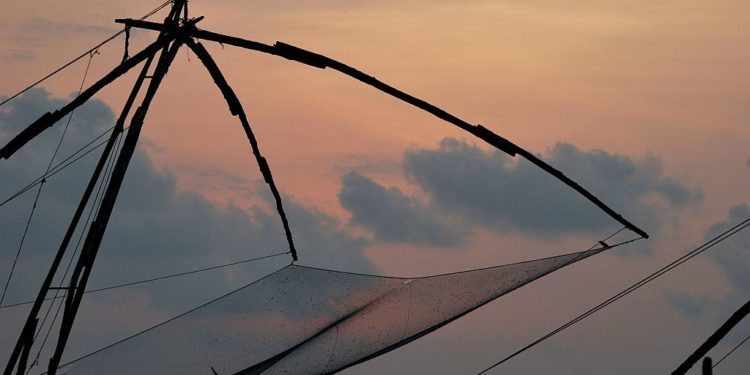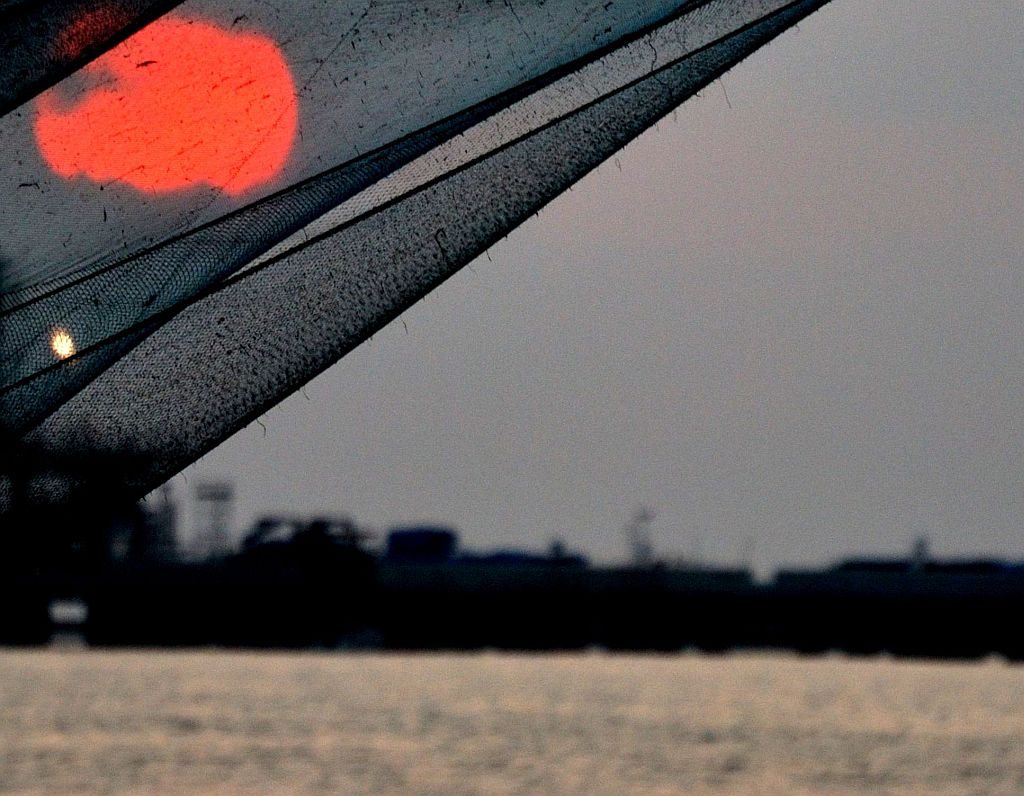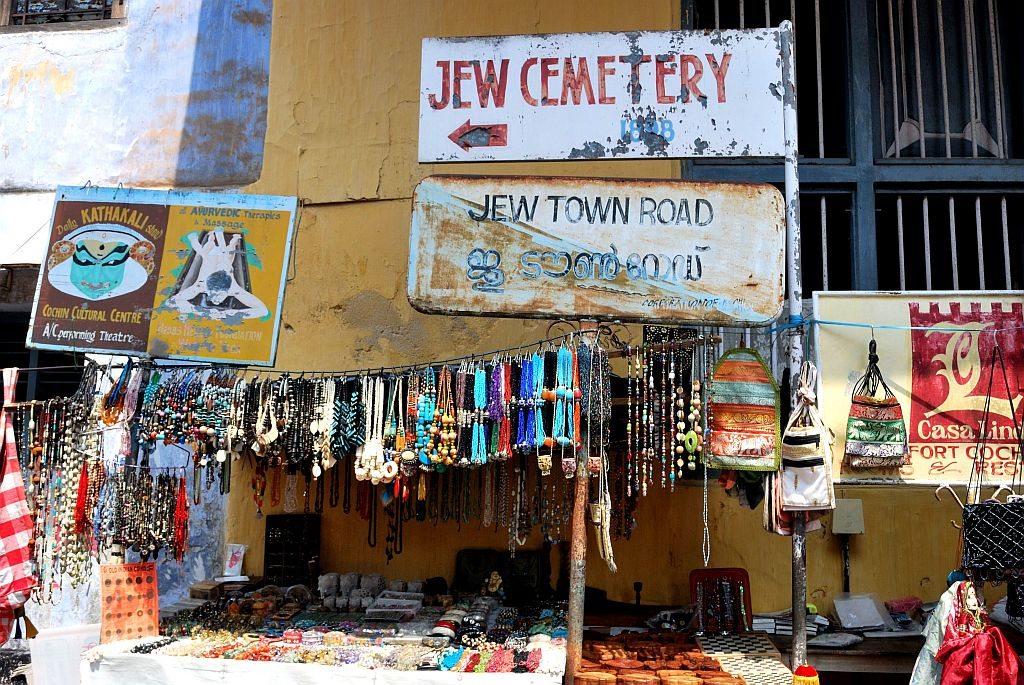A day in Fort Kochi in Kerala

A colourless sky and a moody twilight hour is all that I get when I land in Fort Kochi in Kerala. The monsoons are here and sheets of rain have been persistently tearing down the settlement, leaving puddles and slush everywhere. There is no romance in these rains; it is just a steady downpour and it feels like the clouds are on a mission finishing off a particular ritual to precision.
A short hiatus and the children jump onto the boats as I watch the silhouette of the Chinese fishing nets against the grey skies. Just as I decide to leave the shores , I watch a tiny peep of crimson, reflecting through the nets . The sun probably wanted one final moment in a day that was not his and he was not going to be denied that chance.
Just a light pink glow, the only speck of colour that stood out in the monochromic landscape , before he vanished into the horizon.
Walking aimlessly into the many bylanes of Fort Kochi, I stop by at an art café and then watch a Kathakali performance, before tucking in a quiet dinner in an old colonial building, characterised with a simple courtyard filled with pillars. And listening to the rumble of the skies in the night, I realize that the essence of Fort Kochi lies in its mosaic of cultures – some of them which remain as different as chalk and cheese. Sample this – a Portuguese settlement with a Dutch palace, a tourist hangout with Chinese fishing nets, a Jew town where Kashmiri handicrafts are sold, an erstwhile trading hub which now morphs into a lively spice market and a liberal dose of Kathakali for the tourists. The antique shops and the art cafes are a blend of tradition and the contemporary and it is the potpourri of nationalities and the blend of histories across different timelines that lends itself to the environs around Fort Kochi.
I wake up to the fury of the monsoons in the morning as the rains tumble down. Taking shelter in the 16th century St Francis Church , originally a wooden structure built by the Portuguese inside a fort, I realize that it forms the very nucleus of Fort Kochi. There may be no fort in Fort Kochi today but the tomb of Vasco da Gama here still draws tourists from all over the world. Centuries have passed since the Portuguese explorer breathed his last on Indian soil, but the locals pride over the fact that he was buried here for fourteen years before his mortal remains left for his home country. In the rains, I get my morning dose of history . As the church changed hands from the Portuguese to the Dutch to the British, the patron saints changed as well.
The rains do not deter me as I head to the whole sale market in Mattancherry and lose myself in the old architectural spaces of warehouses and shops. The local traders are a mishmash of various Indian communities and you see them hovering around piles of dry fruits, spices and tea , which are transported and sent to various destinations away from the portals of Fort Kochi. For a moment, my imagination takes me to the days where a medley of foreign merchants would probably be barking orders here.
The warehouses soon give way to bustling shops with colourful walls as pretty doors and windows open up to various aromas of spices. As I walk along the old Jewish quarter, I see a bit of Kashmir and Tibet rubbing shoulders with each other in handicrafts stores. And the mishmash of history, religion and culture is vivid here as three monuments stand adjacent to each other, almost sharing a wall – a Dutch palace, a temple and the Jew synagogue.
I walk towards the Pardesi Synagogue, one of the oldest in the world and gasp at its sheer beauty. The collage of hand painted blue and white tiles made of Chinese porcelain blend with the brass columns and the Belgian hanging lamps . It is another fabric of Fort Kochi that stands out in the melee of vibrant markets and shops.
But is the Dutch palace that turns out to be a showstopper and to me it seems to be the perfect symbol of Fort Kochi with its blend of histories and cultures. Built in a typical Kerala architectural style with a courtyard , it is now a virtual art gallery filled with colourful murals depicting scenes from the Ramayana. And local lore says that it was gifted to the King of Kochi by the Portuguese after a soldier had destroyed a temple in the area. I stand there mesmerised for a while, looking at the paintings waiting for the rains to subside a bit. And it strikes me that while the monsoons give a grey tone to the whole landscape, the variety and the colours of the various worlds here give Fort Kochi its multi hued identity.
Have you been to Fort Kochi ? Do let me know what you thought of it.
What are the other places around Kochi you have visited – I would recommend Thattekadu for birdwatching, Tripunithura for culture, Kumbalangi which is like a model village and Chellanam, a town where boats are built.





Beautiful writeup with lovely photographs. Reading this post makes me want to go to Kochi…
Thanks Amit..Hope you get to visit Kerala soon..
I loved reading it. I have been to Kochi during the monsoons and I know how it feels when the rain simply doesn’t cease. Nice pictures too!
Thanks Renuka..
I love your blog and all the unique quirky places that you get to explore! Lucky you 🙂
I recently visited Kodaikanal and wrote about my adventure here: http://shradhabhatia.com/2014/02/travel-diaries-kodaikanal/
I would really appreciate it if you could take out the time to read it and leave a comment 🙂
Thank you for your helpful post. Keep the great content coming!
Hi Shradha
Thanks for the comment.I did read your Kodai post but I could not comment there..reminded me of my trip a few years ago..Looks like you had a great time.
Nice read about your experiences in Fort Kochi.
Thanks so much Niranjan
I find your blogs more interesting, fascinating and engaging more than the ones that are published in National Geographic. Reading your blogs I feel as if I am traveling through the place.
Thanks so much Pradipna
liked your post
Fort Cochin has been my backyard for more than two decades ,history seeps out of its stuccato walls and cobbled paths ,its European streets ,gabled houses dipping Chinese nets ,ebonied fishermen in their swaying boats in poring rains all capture its spirit which is the melding of ethnic Malyalee with Angloindian ,European and Islamic flavors ,its a cauldron like none
a true melting pot of cuisines smells flavors and sights unseen
a couple of my posts related to this area
http://hariwrite.blogspot.com/2007/01/bose-krishnamachari.html
http://hariwrite.blogspot.com/2014/01/last-jew-of-cochin.html
@Lakshmi, you have just made me feel nostalgic through this article of yours. Kochi is indeed a place worth visiting. I love the aroma of spices and just relived it when I saw the photograph. I am just hoping to visit Kochi again in my next trip to Kerala.
Glad you liked it..hope you get to visit there soon..
Excellent writing and good Photography..
I have been in Fort Kochi Last Monsoon, There are really a beautiful place Kerela for a monsoon season.
Just got back from Kochi…love the vibe that Fort Kochi has!
http://tickingthebucketlist.blogspot.in/2014/07/kerala-vegetarian-food-trail.html
Hello lakshmi,
I am planning a trip to kochi and I dnt have an itinerary or something so am basically clueless on what to see and where to go in Kochi. What places do u think is a never miss wen u go to kochi for the first tym?. Any suggestions on food? And where do u think is a place to go wen u want to take a stroll and just breathe in kochi.
Thank u
Hi
Do visit Fort Kochi, the Jew Town, Chinese Fishing nets, the Dutch Palace..you will find a few cafes and restaurants in the area.besides this you can go to Ernakulam, the old town ..
Hello,
While you are in Fort Kochi do check out Ayana Fort Kochi. It is a 200 year old heritage property built as a courthouse in the Portuguese era and since then converted into a hotel. It is a treat for art lovers with an Art Decor design theme and contemporary art pieces on display throughout the property. (PS: they are on sale too should one wish to make a purchase)